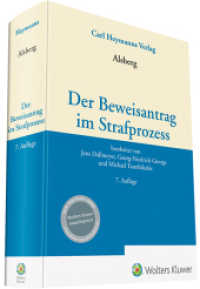Full Description
Reforming the United Nations - Fit for Purpose at 75? - examines the efforts of Secretary-General, António Guterres, to improve the aging organisation during 2017-2019. On development, the global network was repositioned better to assist countries. On peace and security, the Secretariat was reorganised with a focus on conflict prevention. On management, the paradigm centred on decentralisation and accountability. Other priorities addressed sexual exploitation in peacekeeping and gender parity. The detail analysis of the reform process highlights the positions of the United States, Russia, China, the Group of 77 and the European Union. Official records are used. The Guterres reform was respectable by improving efficiency and effectiveness. Reform proposals did not, however, address fundamental problems including Security Council reform.
Contents
Preface
Abbreviations
List of Figures
1 Short History of UN Reform
1.1 Early Years, 1946-1953
1.1.1 Trygve Lie of Norway
1.2 Cold War and North-South Conflict, 1953-1991
1.2.1 Dag Hammarskjöld of Sweden
1.2.2 U Thant of Burma
1.2.3 Kurt Waldheim of Austria
1.2.4 Javier Pérez de Cuéllar of Peru
1.3 Rediscovery and Challenges, 1992-2016
1.3.1 Boutros Boutros-Ghali of Egypt
1.3.2 Kofi Annan of Ghana
1.3.3 Ban Ki-moon of South Korea
1.4 Reform of the Security Council
2 Secretary-General António Guterres: A Difficult Start and Early Reform Priorities
2.1 US President Donald Trump
2.2 Guterres's Early Reform Initiatives
2.3 Sexual Exploitation and Abuse
2.3.1 New Approach
2.3.2 Fifth Committee Review and the Member States' Position
2.3.3 Approval of the ga Resolution on Sexual Exploitation and Abuse
2.3.4 Voluntary Compact and Circle of Leadership
2.4 Gender Parity
2.4.1 System-Wide Strategy on Gender Parity
2.5 Towards a Comprehensive Reform Agenda
2.5.1 Declaration on UN Reform
3 Development Pillar
3.1 Quadrennial Comprehensive Policy Review (QCPR)
3.1.1 Independent Team of Advisors
3.1.2 QCPR Landmark Resolution 71/243
3.2 Repositioning the UN Development System: First Report (A/72/124-E/2018/3)
3.2.1 ECOSOC and the Second Committee of the GA Consider the First Report on the UN Development System
3.3 Repositioning the UN Development System: Second Report (A/72/684-E/2018/7)
3.3.1 ECOSOC Review of Reform Proposals
3.3.2 Intergovernmental Consultations within the Framework of the ga
3.3.3 Reform Resolution 72/279
3.3.4 UNCT
3.3.5 UNRC
3.3.6 Regional Approach
3.3.7 Funding the UN Development System
3.3.8 Follow-up on the Repositioning Efforts of the UN Development System
3.4 Member States' Positions
3.5 Funding Compact
3.6 DESA and Regional Commissions
4 The Peace and Security Pillar
4.1 The High-Level Advisory Board on Mediation
4.2 Budget Pressure
4.3 Restructuring of the Peace and Security Architecture: First Report (A/72/525)
4.3.1 Intergovernmental Consultations
4.3.2 Approval of the First Report by ga Resolution 72/199
4.4 Restructuring the Peace and Security Architecture: Second Report (A/72/772)
4.4.1 Review by the acabq
4.4.2 Approval of the Second Report
4.5 Member States' Positions
4.6 Action for Peacekeeping (A4P)
4.6.1 The Secretary-General Launched A4P
4.6.2 The Declaration of Shared Commitments on UN Peacekeeping Operations
4.6.3 A Peacekeeping Task Force to Support A4P
4.6.4 A4P Champions
5 The Management Pillar
5.1 A New Management Paradigm: First Reports (A/72/492, A/72/492/Add.1)
5.1.1 Staff Were Briefed on Management Reform
5.1.2 The New Management Paradigm and Planning and Budget Process Are Issued
5.1.3 Review by the acabq
5.1.4 The Assembly Endorses the New Management Paradigm and Approves the New Planning and Budgetary Process
5.2 The New Management Paradigm: Second Report (A/72/492/Add.2)
5.2.1 The Second Report on the New Management Paradigm Is Issued
5.2.2 ACABQ Review of the New Management Architecture
5.2.3 The Secretary-General Briefs Member States on the New Management Paradigm
5.2.4 The Assembly Approves the New Management Paradigm
5.3 Member States' Positions
5.4 Outstanding Issues: Information and Communication Technology (ICT), The Global Service Delivery Model and Human Resources Management
5.4.1 Information Technology (IT)
5.4.2 The Global Service Delivery model
5.4.3 Human Resources Management
6 Implementation of Reform
6.1 The Implementation Plan
6.2 1 January 2019: Commencement of the Reform
6.3 The Development Pillar
6.3.1 The Second Implementation Report, April 2019
6.3.2 ECOSOC Reviews the Second Implementation Report
6.3.3 The Third Implementation Report, April 2020
6.4 The Member States' Position
6.5 The Peace and Security Pillar
6.6 The Management Pillar
7 Reforming the United Nations: Fit for Purpose at 75?
7.1 Reform Issues
7.2 The Reform Process and Member States' Position
7.3 Conclusion
Appendix I Short Introduction to the UN
1 Governing Bodies (the GA, the Security Council, ECOSOC, the ACABQ)
2 The Secretariat and Peacekeeping
3 Funds, Programmes, Specialised Agencies and Related Organisations
4 The UN System and the UN Development System
Appendix II Chronology of UN Reform Process
Appendix III UN Documents
1 Secretary-General's Reports
1.1 GA-ECOSOC Report A/72/124-E/2018/3, Repositioning the United Nations Development System to Deliver on the 2030 Agenda: Ensuring a Better Future for all, Report of the Secretary-General, 11 July 2017 [See Chapter 3.2]
1.2 GA Report A/72/492, Shifting the Management Paradigm in the United Nations: Ensuring a Better Future for all, Report of the Secretary-General, 27 September 2017 [See Chapter 5.1]
1.3 GA Report A/72/525, Restructuring of the United Nations Peace and Security Pillar, Report of the Secretary-General, 13 October 2017 [See Chapter 4.1]
1.4 GA-ECOSOC Report A/74/73-E/2019/14, Implementation of General Assembly Resolution 71/243 on the Quadrennial Comprehensive Policy Review of Operational Activities for Development of the United Nations system, 2019, Report of the Secretary-General, 15 April 2019 [See Chapter 6.1]
2. Resolutions
2.1 GA Resolution 71/243, Quadrennial Comprehensive Policy Review of Operational Activities for Development of the United Nations System, Adopted 21 December 2016, Issued 1 February 2017 [See Chapter 3.1]
2.2 GA Resolution 72/199, Restructuring of the United Nations Peace and Security Pillar, Adopted 20 December 2017, Issued 19 January 2018 [See Chapter 4.1]
2.3 GA Resolution 72/236, Operational Activities for Development of the United Nations System, Adopted 20 December 2017, Issued 18 January 2018 [See Chapter 3.2]
2.4 GA Resolution 72/266 A, Shifting the Management Paradigm in the United Nations, Adopted 24 December 2017, Issued 15 January 2018 [See Chapter 5.1]
2.5 GA Resolution 72/279, Repositioning of the United Nations Development System in the Context of the Quadrennial Comprehensive Policy Review of Operational Activities for Development of the United Nations System, Adopted 31 May 2018, Issued 1 June 2018 [See Chapter 3.3]
2.6 GA resolution 72/262 C iii, Revised Budget Estimates for the Period from 1 July 2018 to 30 June 2019 Related to the Peace and Security Reform, Adopted 5 July 2018, Issued 18 July 2018 [See Chapter 4.2]
2.7 GA Resolution 72/266 B, Shifting the Management Paradigm in the United Nations, Adopted 5 July 2018, Issued 17 July 2018 [See Chapter 5.2]
2.8 GA Resolution 73/248, Operational Activities for Development of the United Nations System, Adopted 20 December 2018, Issued 14 January 2019 [See Chapter 3.1]
2.9 ECOSOC Resolution 2019/15, Progress in the Implementation of General Assembly Resolution 71/243 on the Quadrennial Comprehensive Policy Review of Operational Activities for Development of the United Nations System, Adopted 8 July 2019, Issued 12 July 2019 [See Chapter 6.1]
2.10 GA Resolution 74/238, Operational Activities for Development of the United Nations System, Adopted 19 December 2019, Issued 10 January 2020 [See Chapter 6.1]
2.11 GA Resolution 75/1, Declaration on the Commemoration of the Seventy-Fifth Anniversary of the United Nations, 21 September 2020 [See Chapter 7]
3. ACABQ Reports
3.1 GA Report A/72/7/Add.24, Shifting the Management Paradigm in the United Nations: Ensuring a Better Future for all: Improving and Streamlining the Programme Planning and Budgeting Process, Report of the acabq, 22 November 2017 [See Chapter 5.1]
3.2 GA report A/72/859, Revised Budget Estimates for the Period from 1 July 2018 to 30 June 2019 Related to the Peace and Security Reform, Report of the acabq, 8 May 2018 [See Chapter 4.2]
3.3 GA Report A/72/7/Add.49, Shifting the Management Paradigm in the United Nations: Implementing a New Management Architecture for Improved Effectiveness and Strengthened Accountability, Report of the acabq, 25 May 2018 [See Chapter 5.2]
Bibliography
Index








